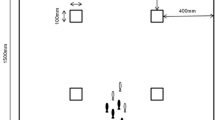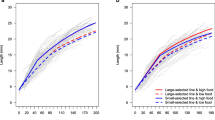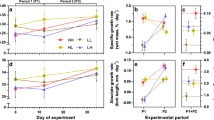Abstract
Growth and energy metabolism are highly flexible in fish species in response to food availability, and these two traits depend to some extent on the social rearing environment (e.g., isolated vs. group rearing). Currently, how social rearing environments influence flexibility in metabolic rate of fish and their ecological consequences (e.g., somatic growth) remain largely unknown. Here, we investigated how social isolation (i.e., group-reared vs. isolation-reared) and food availability (i.e., high vs. low) affect metabolic rates, growth and their correlations in a group-living fish, grass carp (Ctenopharyngodon idella), which were subjected to a 4-week growth experiment. The metabolic rates (e.g., standard metabolic rate, SMR; maximum metabolic rate, MMR; aerobic scope, AS = MMR–SMR) and morphology (e.g., body mass and length) of the fish in four treatments were measured at the beginning and end of the growth experiment, and then the growth parameters (e.g., food intake, FI; feeding efficiency, FE; and specific growth rate, SGR) were also obtained. We found that social isolation did impair growth of fish with individuals showing a lower SGR compared to those group-reared fish irrespective of food availability. However, the growth advantage of group-reared fish under two food availabilities did not result from their FIs or FEs. Metabolic rates (i.e., SMR) seemed to decrease in response to social isolation, but increased greater when fish were reared at high food ration. These shifts in metabolic rates were positively linked with individual differences in somatic growth; individuals who increased metabolic rates more grew faster, while those who increased their metabolic rates less or even reduced had a lower growth, but these links were independent on both social isolation and food ration. These results suggested that social isolation can inhibit the growth of individual fish, but not the AS. Flexibility in metabolic rates could confer a growth advantage under changing food availability, but the links between variation in energy metabolism and growth were not altered by social deprivation. Our study demonstrates the importance of metabolic plasticity accounting for inter-individual difference in growth performance under the challenges of changing food resource.




Similar content being viewed by others
References
Álvarez D, Nicieza AG (2005) Is metabolic rate a reliable predictor of growth and survival of brown trout (Salmo trutta) in the wild? Can J Fish Aquat Sci 62:643–649
Auer SK, Salin K, Rudolf AM, Anderson GJ, Metcalfe NB (2015a) Flexibility in metabolic rate confers a growth advantage under changing food availability. J Anim Ecol 84:1405–1411
Auer SK, Salin K, Rudolf AM, Anderson GJ, Metcalfe NB (2015b) The optimal combination of standard metabolic rate and aerobic scope for somatic growth depends on food availability. Funct Ecol 29:479–486
Auer SK, Salin K, Anderson GJ, Metcalfe NB (2016) Flexibility in metabolic rate and activity level determines individual variation in overwinter performance. Oecologia 182:703–712
Auer SK, Solowey JR, Rajesh S, Rezende EL (2020) Energetic mechanisms for coping with changes in resource availability. Biol Lett 16:20200580
Bochdansky AB, Grøkjӕr P, Herra TP, Leggett WC (2005) Experimental evidence for selection against fish larval with high metabolic rates in a food limited environment. Mar Biol 147:1413–1417
Bolger T, Connolly PL (1989) The selection of suitable indices for the measurement and analysis of fish condition. J Fish Biol 34:171–182
Bozinovic F, Rojas JM, Broitman BR, Vásquez RA (2009) Basal metabolism is correlated with habitat productivity among populations of degus (Octodon degus). Comp Biochem Physiol A Mol Integr Physiol 152:560–564
Burton T, Killen SS, Armstrong JD, Metcalfe NB (2011) What causes intraspecific variation in resting metabolic rate and what are its ecological consequences? Proc Biol Sci 278:3465–3473
Baloi MF, Sterzelecki FC, Sugai JK, Passini G, Carvalho CVA, Cerqueira VR (2017) Growth performance, body composition and metabolic response to feeding rates in juvenile Brazilian sardine Sardinella brasiliensis. Aquac Nutri 2:1–9
Chabot D, Steffensen JF, Farrell AP (2016) The determination of standard metabolic rate in fishes. J Fish Biol 88:81–121
Claireaux G, Handelsman C, Standen E (2007) Thermal and temporal stability of swimming performance in the European sea bass. Physiol Biochem Zool 80:186–196
Dibattista JD, Levesque HM, Moon TW, Gilmour KM (2006) Growth depression in socially subordinate rainbow trout (oncrohynchus mykiss): more than a fasting effect. Physiol Biochem Zool 79:675–687
Ding RH (1994) The fishes of Sichuan. Sichuan Science and Technology Press, Sichuan
Earley RL, Edwards JT, Aseem O, Felton K, Blumer LS, Karom M, Grober MS (2006) Social interactions tune aggression and stress responsiveness in a territorial cichlid fish (Archocentrus nigrofasciatus). Physiol Behav 88:353–363
Forsatkar MN, Safari O, Boiti C (2017) Effects of social isolation on growth, stress response, and immunity of zebrafish. Acta Ethol 20:255–261
Fu SJ, Peng J, Killen SS (2018) Digestive and locomotor capacity show opposing responses to changing food availability in an ambush predatory fish. J Exp Biol 221:jeb.173187
Gersick AS, Snyder-Mackler N, White DJ (2012) Ontogeny of social skills: social complexity improves mating and competitive strategies in male brown-headed cowbirds. Anim Behav 83:1067–1074
Gómez-Laplaza LM, Morgan E (2000a) The effect of time spent in isolation on the response to novel nonsocial stimulation in the angelfish Pterophyllum scalare. Can J Zool 78:530–537
Gómez-Laplaza LM, Morgan E (2000b) Laboratory studies of the effects of short-term isolation on aggressive behaviour in fish. Mar Freshw Behav Physiol 33:63–102
Ghulam A, Pirzadaja S (2009) Effects of different feeding level on the growth, feed efficiency and body composition of juvenile mangrove red snapper, Lutjanu argentimaculatus (Forsskal 1775). Aquac Res 40:781–789
Håkan Olsén K, Winberg S (1996) Learning and sibling odor preference in juvenile arctic char, Salvelinus alpinus (L.). J Chem Ecol 22:773–786
Hesse S, Bakker TCM, Baldauf SA, Thünken T (2012) Kin recognition by phenotype matching is family- rather than self-referential in juvenile cichlid fish. Anim Behav 84:451–457
Hesse S, Thünken T (2014) Growth and social behavior in a cichlid fish are affected by social rearing environment and kinship. Naturwissenschaften 101:273–283
Hesse S, Sandmann S, Bakker TCM, Thunken T (2019) Impact of social rearing-environment on performance in a complex maze in females of a cichlid fish. Behav Proc 167:103915
Jobling M (1994) Fish bioenergetics. Chapman & Hall, London
Jolles JW, King AJ, Killen SS (2020) The role of individual heterogeneity in collective animal behaviour. Trends Ecol Evol 35:278–291
Krause J, Ruxton GD (2002) Living in groups. Oxford University Press, New York
Kanitz E, Tuchscherer M, Puppe B, Tuchscherer A, Stabenow B (2004) Consequences of repeated early isolation in domestic piglets (Sus scrofa) on their behavioural, neuroendocrine, and immunological responses. Brain Behav Immun 18:35–45
Killen SS, Marras S, Mckenzie DJ (2011) Fuel, fasting, fear: routine metabolic rate and food deprivation exert synergistic effects in risk-taking in individual juvenile European sea bass. J Anim Ecol 80:1024–1033
Killen SS, Marras S, Nadler L, Domenici P (2017) The role of physiological traits in assortment among and within fish shoals. Philos Trans R Soc B 372:20160233
Killen SS, Christensen EAF, Cortese D, Zavorka L, Norin T, Cotgrove L, Crespel A, Munson A, Nati JJH, Papatheodoulou M, McKenzie DJ (2021) Guidelines for reporting methods to estimate metabolic rates by aquatic intermittent-flow respirometry. J Exp Biol 224(18):jeb242522
Kotrschal A, Szidat S, Taborsky B (2014) Developmental plasticity of growth and digestive efficiency in dependence of early-life food availability. Func Ecol 28:878–885
Liu S, Fu SJ (2017) Effects of food availability on metabolism, behaviour, growth and their relationships in a triploid carp. J Exp Biol 220:4711–4719
Ling H, Fu SJ, Zeng LQ (2019) Predator stress decreases standard metabolic rate and growth in juvenile crucian carp under changing food availability. Comp Biochem Physiol A 231:149–157
McCue MD (2010) Starvation physiology: reviewing the different strategies animals use to survive a common challenge. Comp Biochem Physiol A Mol Integr Physiol 156:1–18
Mccarthy ID (2010) Temporal repeatability of relative standard metabolic rate in juvenile Atlantic salmon and its relation to life history variation. J Fish Biol 57:224–238
Metcalfe NB, Van Leeuwen TE, Killen SS (2016) Does individual variation in metabolic phenotype predict fish behaviour and performance? J Fish Biol 88:298–321
Mueller P, Diamond J (2001) Metabolic rate and environmental productivity: well-provisioned animals evolved to run and idle fast. Proc Natl Acad Sci USA 98:550–554
Norin T, Malte H (2011) Repeatability of standard metabolic rate, active metabolic rate and aerobic scope in young brown trout during a period of moderate food availability. J Exp Biol 214:1668–1675
Norin T, Clark TD (2016) Measurement and relevance of maximum metabolic rate in fishes. J Fish Biol 88:122–151
Norin T, Metcalfe NB (2019) Ecological and evolutionary consequences of metabolic rate plasticity in response to environmental change. Philos Trans R Soc B 374:20180180
Otsuka A, Inahata M, Shimomura Y, Kagawa N (2020) Physiological changes in response to social isolation in male medaka fish. Fish Sci 85:775–781
Priyadarshana T, Asaeda T, Mantunge J (2006) Hunger-induced foraging behavior of two cyprinid fish: Pseudorasbora parva and Rasbora daniconius. Hydrobiologia 568:341–352
Pritchard LM, Van Kempen TA, Zimmerberg B (2013) Behavioral effects of repeated handling differ in rats reared in social isolation and environmental enrichment. Neurosci Lett 536:47–51
Reid D, Armstrong JD, Metcalfe NB (2012) The performance advantage of a high resting metabolic rate in juvenile salmon is habitat dependent. J Anim Ecol 81:868–875
Roche DG, Binning SA, Bosiger Y, Johansen JL, Rummer JL (2013) Finding the best estimates of metabolic rates in a coral reef fish. J Exp Biol 216:2103–2110
Ros-Simo C, Valverde O (2012) Early-life social experiences in mice affect emotional behaviour and hypothalamic-pituitary-adrenal axis function. Pharmacol Biochem Behav 102:434–441
Schons RF, Vitt S, Thünken T (2021) Resource heterogeneity but not inbreeding affects growth and grouping behaviour in socially foraging juvenile cichlid fish. Funct Ecol 36:550–560
Schmidt-Nielsen K (1991) Animal physiology. Cambridge University Press, Cambridge
Shams S, Seguin D, Facciol A, Chatterjee D, Gerlai R (2017) Effect of social isolation on anxiety-related behaviors, cortisol, and monoamines in adult zebrafish. Behav Neurosci 131:492–504
Steffensen JF, Bushnell PG, Schurmann H (1994) Oxygen consumption in four species of teleosts from Greenland: no evidence of metabolic cold adaptation. Polar Biol 14:49–54
Toth M, Mikics E, Tulogdi A, Aliczki M, Haller J (2011) Post-weaning social isolation induces abnormal forms of aggression in conjunction with increased glucocorticoid and autonomic stress responses. Horm Behav 60:28–36
Ultsch GR (1995) On adjusting metabolic rates for body size. Florida Sci 58:270–273
Veenema AH (2009) Early life stress, the development of aggression and neuroendocrine and neurobiological correlates. What can we learn from animal models? Front Neuroendocrin 30:497–518
Van Leeuwen TE, Rosenfeld JS, Richards JG (2012) Effects of food ration on SMR: influence of food consumption on individual variation in metabolic rate in juvenile coho salmon Onchorhynchus kisutch. J Anim Ecol 81:395–402
Zhao X, Sun L, Jia H, Meng Q, Wu S, Li N, He S (2009) Isolation rearing induces social and emotional function abnormalities and alters glutamate and neurodevelopment-related gene expression in rats. Prog Neuro Psycho Pharmacol Biol Psychiatry 33:1173–1177
Zeng LQ, Li FJ, Li XM, Cao ZD, Fu SJ, Zhang YG (2012) The effects of starvation on digestive tract function and structure in juvenile southern catfish (Silurus meridionalis Chen). Comp Biochem Physiol A 162:200–211
Zeng LQ, Fu SJ, Li XM, Li FJ, Li B, Cao ZD, Zhang YG (2014) Physiological and morphological responses to the first bout of refeeding in southern catfish (Silurus meridionalis). J Comp Physiol B 184:329–346
Zeng LQ, Wang L, Wang GN, Zeng Y, Fu SJ (2017a) The relationship between growth performance and metabolic rate flexibility varies with food availability in juvenile qingbo (Spinibarbus sinensis). Comp Biochem Physiol A 212:56–63
Zeng LQ, Zhang AJ, Killen SS, Cao ZD, Wang YX, Fu SJ (2017b) Standard metabolic rate predicts growth trajectory of juvenile crucian carp (Carassius auratus) under changing food availability. Biol Open 6:1305–1309
Zeng LQ, Fu C, Fu SJ (2018) The effects of temperature and food availability on growth, flexibility in metabolic rates and their relationships in juvenile common carp. Comp Biochem Physiol A 217:26–34
Acknowledgements
We thank Wu-Xin Li, Rong Chen, Qi-Miao Hou and Ning Zhang for their help with the experiment. Our study was supported by grants from the National Science Foundation of China (31300341), the Science and Technology Research Program of Chongqing Municipal Education Commission (KJQN201900540, KJQN202000539), and the Venture and Innovation Support Program for Chongqing Overseas Returnees (cx2019153) to L.Q.Z. We are very thankful to Prof. Neil Metcalfe and an anonymous reviewer for their insightful comments and constructive suggestions on the manuscript.
Author information
Authors and Affiliations
Corresponding author
Ethics declarations
Conflict of interest
The authors declare that they have no conflicts of interest.
Additional information
Communicated by B. Pelster.
Publisher's Note
Springer Nature remains neutral with regard to jurisdictional claims in published maps and institutional affiliations.
Supplementary Information
Below is the link to the electronic supplementary material.
Rights and permissions
Springer Nature or its licensor (e.g. a society or other partner) holds exclusive rights to this article under a publishing agreement with the author(s) or other rightsholder(s); author self-archiving of the accepted manuscript version of this article is solely governed by the terms of such publishing agreement and applicable law.
About this article
Cite this article
Sun, CY., Fu, SJ. & Zeng, LQ. Social isolation does not alter the relationship between flexibility in metabolic rate and growth in grass carp (Ctenopharyngodon idella) under changing food availability. J Comp Physiol B 193, 95–108 (2023). https://doi.org/10.1007/s00360-022-01467-0
Received:
Revised:
Accepted:
Published:
Issue Date:
DOI: https://doi.org/10.1007/s00360-022-01467-0




